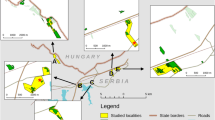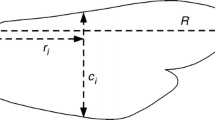Summary
By various observations on carabid populations the author attempts to give an impression of the quantitative occurrence of dispersal and of the relation between dispersal and the chance of founding populations (dispersal power). Pitfall-catches in the recently reclamed “Zuiderzee”-polder E-Flevoland demonstrate that within seven years individuals of a number of monomorphic macropterous and dimorphic species had founded populations there. From the very high frequency of full-winged individuals within the latter populations it follows that full-winged carabid individuals generally must have a much greater power of dispersal than flightless ones. Therefore, winged individuals of dimorphic species were about equally able to reach E-Flevoland as were those of monomorphic macropterous ones, whereas individuals of monomorphic brachypterous species obviously are seriously hampered. The early appearance of individuals of riparian species on the shores of an artificial lake in the dune area “Meijendel” suggests that particularly populations living in unstable environments extensively “invest” in dispersal. It appears, however, that an important “investment” in dispersal apparently is not restricted to species from unstable environments; at least some sparse populations living in more stable environments also “sacrifice” relatively great numbers of individuals for dispersal (Pterostichus strenuus). The hypothesis is proposed, that populations facing a high risk of extinction generally will have a sufficient chance of founding populations (high “turnover”) when “investing” extensively in dispersal. Not only macropterous but — at least in some populations — also brachypterous individuals participate in migration, although in the populations studied the dispersal power of flightless individuals is found to be very small (Carabus problematicus). Under certain conditions the dispersal of full-winged individuals from wing-dimorphic populations may ultimately lead to a decrease or even a loss of dispersal power by a decrease of the frequency of macropterous individuals. It is assumed, however, that under certain natural conditions also brachypterous individuals may contribute to the spreading of risk within and between populations. The dispersal power of monomorphic macropterous, dimorphic and monomorphic brachypterous populations in a cultivated countryside like Drenthe is discussed. The connection between the dispersal power of different kinds of carabid populations and the resulting chance of survival under different conditions is discussed. Some suggestions for nature preservation management are given.
Similar content being viewed by others
References
Andrewartha, H. G., Birch, L. C.: The distribution and abundance of animals. Chicago: Chicago Univ. Press 1954.
Boer, P. J. den: The ecological significance of activity patterns in the woodlouse Porcellio scaber Latr. (Isopoda). Arch. néerl. Zool. 14, 283–409 (1961).
—: Zwei neue Laufkäferarten (Coleopt., Carabidae) in der niederländischen Fauna. (Twee nieuwe loopkeversoorten voor de Nederlandse fauna.) [Holl.] Ent. Ber. 22, 88–95 (1962a).
—: Flügeldimorphismus in Laufkäfer als Anzeiger in Tiergeografischen Untersuchengen. (Vleugeldimorfisme bij loopkevers als indicator bij zoögeografisch onderzoek.) [Holl.]. Vakbl. Biol. 42, 110–119 (1962b).
—: External characters of sibling species Trechus obtusus Er. and T. quadristriatus Shrk. (Coleoptera). T. Ent. 108, 219–239 (1965).
—: Die Relativität der Seltenheit. (De relativiteit van zeldzaamheid.) [Holl.]. Ent. Ber. 27, 52–60 (1967).
—: Spreading of risk and stabilization of animal numbers. Acta biotheor. (Leiden) 18, 165–194 (1968).
Brinkhurst, R. O.: Alary polymorphism in the Gerroidea (Hemiptera-Heteroptera). J. anim. Ecol. 28, 211–230 (1959).
Dahl, F.: Die Tierwelt Deutschlands. 7. Coleoptera oder Käfer. I. Carabidae (Laufkäfer). Jena: Gustav Fischer 1928.
Darlington, P. J.: Variation and atrophy of flying wings of some Carabid beetles. Ann. Ent. Soc. Amer. 29, 136–179 (1936).
—: Carabidae of mountains and islands. Ecol. Monogr. 13, 37–61 (1943).
—: Zoogeography. New York: John Wiley 1957.
Elton, Ch. S.: The ecology of invasions. London: Methuen 1958.
Heydemann, B.: Die Carabiden der Kulturbiotope von Binnenland und Nordseeküste — ein ökologischer Vergleich (Coleopt., Carabidae). Zool. Anz. 172, 49–86 (1964).
Jackson, D. J.: The inheritance of long and short wings in the weevil Sitonia hispidula, with a discussion of wing reduction among beetles. Trans. roy. phys. Soc. (Edinb.) 55, 665–735 (1928).
—: Observations on the flight muscles of Sitonia weevils. Ann. appl. Biol. 20, 731–771 (1933).
Jonge, H. de: Inleiding tot de medische statistiek. I. 2e druk. 421 p. Verh. Ned. Inst. Praev. Geneesk. XLI (1963).
Kendall, M. G.: Rank correlation methods, 3rd ed. London: Charles Griffin 1962.
Lindroth, C. H.: Die Fennoskandischen Carabidae. I. Göteborgs kgl. Vetensk. Handl. B 4 (1), 1–709 (1945a).
—: Die Fennoskandischen Carabidae. II. Göteborgs kgl. Vetensk. Handl. B 4 (2), 1–277 (1945b).
Lindroth, C. H.: Inheritance of wing dimorphism in Pterostichus anthracinus. III. Hereditas (Lund) 32, 37–40 (1946).
—: Die Fennoskandischen Carabidae. III. Göteborgs kgl. Vetensk. Handl. B 4 (3), 1–911 (1949).
—: Some attempts toward experimental zoogeography. Ecology 34, 657–666 (1953).
—: The faunal connections between Europe and North America. Stockholm: Almqvist & Wiksell 1957.
—: The icelandic form of Carabus problematicus Hbst. (Col., Carabidae). A statistic treatment of subspecies. Opusc. Ent. 33, 157–182 (1968).
Mood, A. M.: Introduction to the theory of statistics. New York: McGraw-Hill 1950.
Palmén, E.: Die anemohydrochore Ausbreitung der Insekten als zoogeographischer Faktor. Ann. Soc. zool. bot. fenn. “Vanamo” 10, 1–262 (1944)
Preston, F. W.: The canonical distribution of commonness and rarity. Ecology 43, 185–215, 410–432 (1962).
Reddingius, J., Boer, P. J. den: Simulation experiments illustrating stabilization of animal numbers by spreading of risk. (In press.)
Rensch, B.: Studden über Korrelation und klimatische Parallelität der Rassenmerkmale von Carabus-Formen. Zool. Jb., Abt., System., Ökol. u. Geogr. 76, 103–170 (1943).
—: Neuere Probleme der Abstammungslehre. Stuttgart: Ferd. Enke 1947.
Siegel, S.: Nonparametric statistics for the behavioral sciences. New York: Mc Graw-Hill 1956.
Spitz, J. C.: Statistiek voor psychologen, pedagogen, sociologen. Amsterdam: Noord Holl. Uitg. Mij. 1965.
Tietze, F.: Untersuchungen über die Beziehungen zwischen Flügelreduktion und Ausbildung des Metathorax bei Carabiden. Beitr. Ent. 13, 88–167 (1963).
Wellington, W. G.: Quantitative changes in populations in unstable environments. Can. Ent. 96, 436–451 (1964).
Williams, C. B.: Patterns in the balance of nature. London: Academic Press 1964;
Author information
Authors and Affiliations
Additional information
Communication No. 144
Rights and permissions
About this article
Cite this article
Den Boer, P.J. On the significance of dispersal power for populations of carabid-beetles (Coleoptera, Carabidae). Oecologia 4, 1–28 (1970). https://doi.org/10.1007/BF00390612
Received:
Issue Date:
DOI: https://doi.org/10.1007/BF00390612




